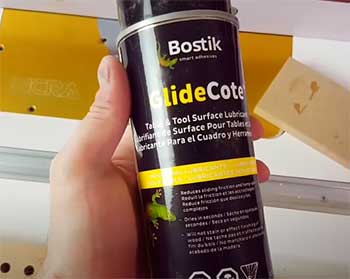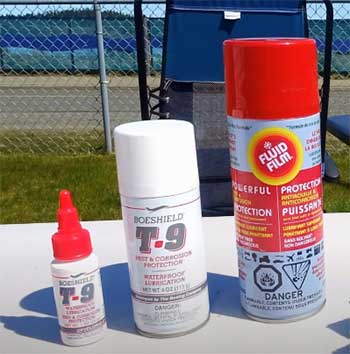If you’re a woodworker, your life will pretty much revolve around your workshop. And it won’t just be for working on your projects. You’ll have to maintain good care of your tools and your workshop so you get the best output possible.
One of the problems woodworkers face with their tools is rusting. The cast iron tools and surfaces are extremely prone to this. And this is where rust-preventing methods come in.
Lubricant sprays like GlideCote and T-9 are the top names for this. So what makes them different? Let’s take a look.
A Quick Comparison Table
If you’re one of the “always-on-the-go” persons, this part is for you. If you want to know the gist of it all minus the fluff, this table notes them down for you. Feel free to go through it for a quick summary.
| Feature | GlideCote | T-9 Boeshield |
| Cleaning | No | Yes |
| Ease of application | Better | Good |
| Cure Time | Less | More |
| Lasting Time | More | Less |
| Finish | Less greasy | More greasy |
| Slickness | More | Less |
Now for the less busy people, let’s get into the details of both products.
Key Differences Between GlideCote And T-9 Boeshield
Whether you’re buying tools for your workshop or something completely different, you can’t make the right decision without knowing anything about your options.
Like every other product, GlideCote and T-9 both bring their own benefits to the table.
Here is a breakdown of the key differences between the two products so you can choose easily and cut back on some confusion.
- Cleaning Properties
For rusting, you’ll have to work double to keep your tools safe. You can take preventative measures but that won’t stop the rust. At least not 100%. So a lot of manufacturers have a line of rust cleaning products.

Some of the manufacturers are a step ahead and combine cleaning agents with sealants/lubricants.
Boeshield’s T-9 does the same, but GlideCote doesn’t have any cleaning properties.
GlideCote works as a lubricant and sealant, that’s about it. The product doesn’t claim to have any cleaning properties and of course, it won’t help you get rid of the rust that’s already on your surfaces.
So you can only use this to stop rust from forming.
Boeshield T-9 is slightly ahead in this department. It is a cleanser and a sealant. It won’t do a squeaky clean surface so you can’t use it instead of maybe your WD-40.
But if you have a surface that already has some rust in it, T-9 can help loosen them up and make cleaning easier.
- Ease of Application
This is one of the tricky parts to compare. Both products have their advantages but if you’re thinking overall, then GlideCote will take the crown. It is easier to apply than T-9 and even paste wax. It is also buildable so you can get the thickness you want.
GlideCote is known in the woodwork community for being easy to work with. It is very easy to spread so you can coat any surface well, and it is very buildable.
It doesn’t take long to be absorbed so if you want a thicker film, you’ll have to apply multiple layers and build it up.
T-9 is a little harder to work with but it is still easier than paste wax. It takes a little longer to be absorbed so it isn’t very buildable. But you can get into every little gap with it so that’s a plus.
The comparison is a little tricky here. GlideCote is better for plain surfaces but it doesn’t do well in terms of narrow spaces. T-9 can get practically everywhere but it is pretty hard to work with.
It gets harder especially if you’re trying to build up a film. Considering the buildability and the coating ease, GlideCote is better than T-9.
- Cure Time
Cure time is pretty much the “drying time” for rust-preventing products. This is how long you’ll have to leave them on the surface to get a protective layer.
GlideCote takes less time in this. T-9 takes more time, but the difference isn’t very big.

Curing time depends on how easily a sealant can penetrate the surface. A sealant with better penetrating power will get into the surface faster so it will take less time to cure.
If the sealant is slower in getting under the surface, you’ll need to cure it for longer.
GlideCote is one of the fastest drying sealants out there. It dries noticeably faster than other sealants and leaves very little residue too.
So you’ll need to cure it for less time. It usually takes around an hour or less (depending on the moisture level of your workshop) to dry.
T-9 is a little slow in the curing department. It takes longer to dry and sometimes there is more leftover on the surface than GlideCote.
You’ll have to cure the surface for around 2 hours to get the product well under the surface.
A lot of people leave the products on for a much shorter time. Usually, a 10-20 minutes timeframe does it for them but it only works if you want a very thin coat.
- Lasting Time
Lasting time is how long a sealant layer lasts. This will tell you how frequently you’ll have to reapply your sealants.
GlideCote lasts for a pretty long time before you have to start thinking about reapplying but T-9 falls short here. You’ll have to apply that one fairly frequently.
GlideCote takes less maintenance and reapplying. You can apply it to your tools and forget about re-applying for at least a few weeks. Depending on the humidity situation of your workshop, it can last you 3 weeks to a few months.
T-9 Boeshield isn’t really bad either. It lasts slightly less than GlideCote but that’s honestly excusable. Depending on your workshop’s humidity, T-9 can last you 2 weeks to multiple months.
So yes, the gap is very slim but GlideCote lasts longer than T-9.
- Finish
Both sealants dry nicely but T-9 tends to be greasier than GlideCote. This is more apparent if the surface isn’t cast iron. GlideCote lubricates well but it usually doesn’t leave off any residue.
GlideCote creates an even layer on the surface. It absorbs quickly so it leaves less residue on the surface. This makes the surface less greasy. This is also why one bottle of GlideCote lasts pretty long.
T-9 is a good sealant, but sometimes it can be a little hard to work with. Since it has less penetrative power, it can leave residue on the surface.
Unless you calculate carefully and apply the exact amount, you’ll be wasting a pretty good amount on every application.
Another problem with T-9 is it can leave streaks and blotches. Most of the time it creates an even layer but sometimes the layer can have streaks on the surface.
This depends more on the moisture level than the product, but it is still a hole that gives some extra points to Glidecote.
- Slickness
This is very much of a direct comparison. GlideCote creates more slickness so the friction level goes down pretty fast. T-9 on the other hand is less slick.
It creates an amazing lubrication layer but that falls short compared to GlideCote.
As you can see, both sealants are good. If you want something you can use everywhere no matter how narrow the space is, go for the T-9.
But if you want more of an all-rounder performance then GlideCote is the best choice for you. Watch this video to understand why.
Frequently Asked Question (FAQs)
Boeshield T-9 has an indefinite shelf life but if you’re talking about the protective layer, it depends on your workshop’s humidity level. T-9 can last from 2 weeks to multiple months depending on the weather.
You’ll have to use a protective sealant for rust prevention. It can be mineral spirit, paste wax or spray sealant.
Absolutely not. According to the official website, T-9 doesn’t contain any silicone or Teflon element.
Yes, Boeshield T-9 dries to a protective layer over your target surface. The thickness of the layer will depend on how much product you’re using.
Final Verdict
And there you have it, a breakdown of Glidecote vs. T9 sealant. Both products are really good at rust protection. So what you pick will come down to your personal use case, and what your nearest hardware store has in their inventory.
Either way, make sure you keep your workspace as moisture-free as possible. Otherwise, the rust protection sealants won’t really be helping.
